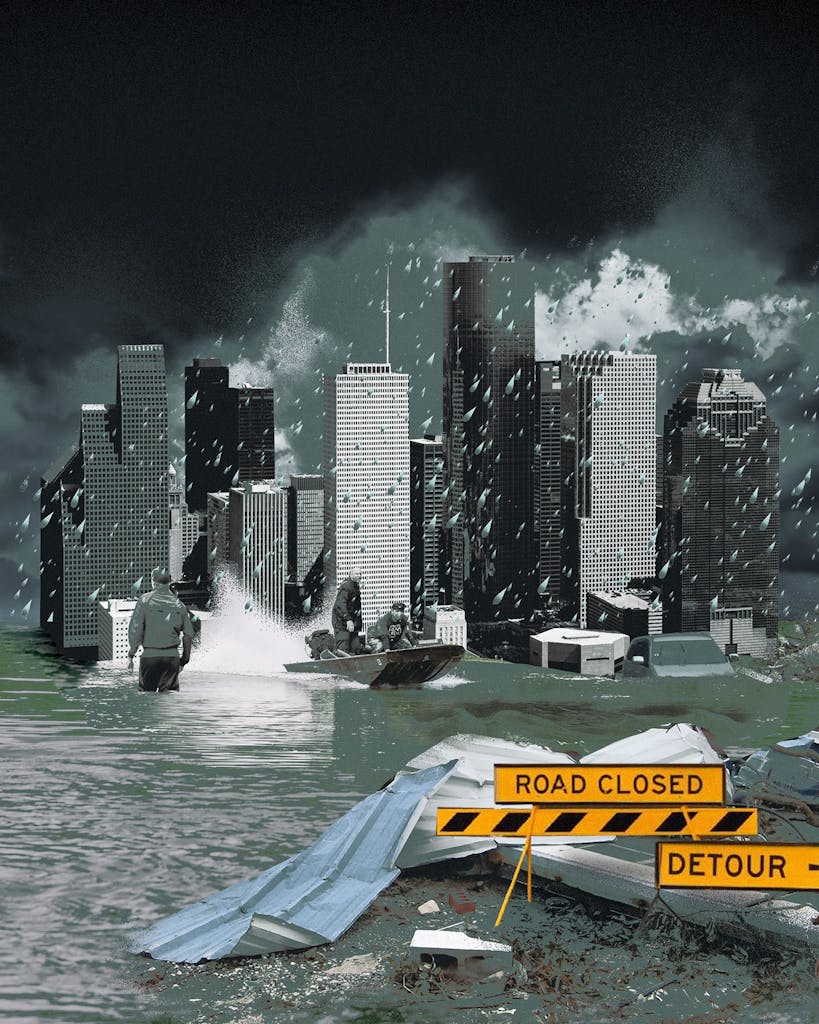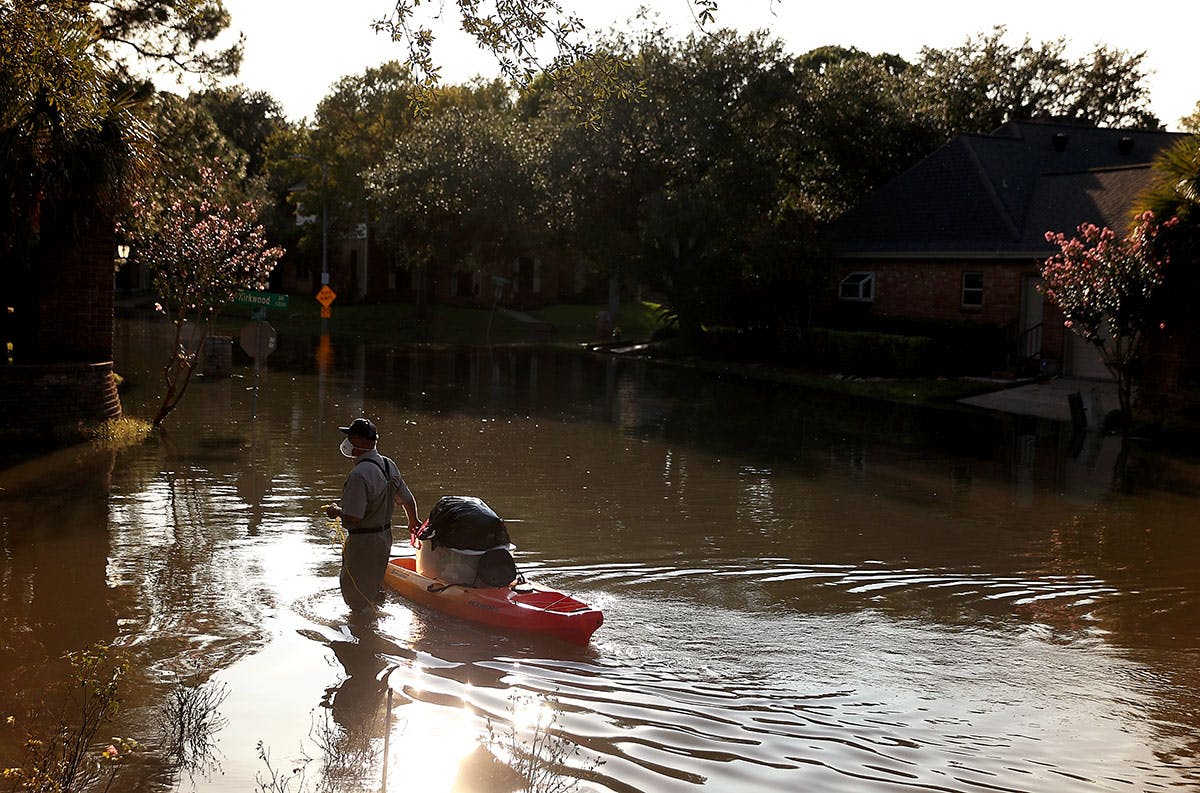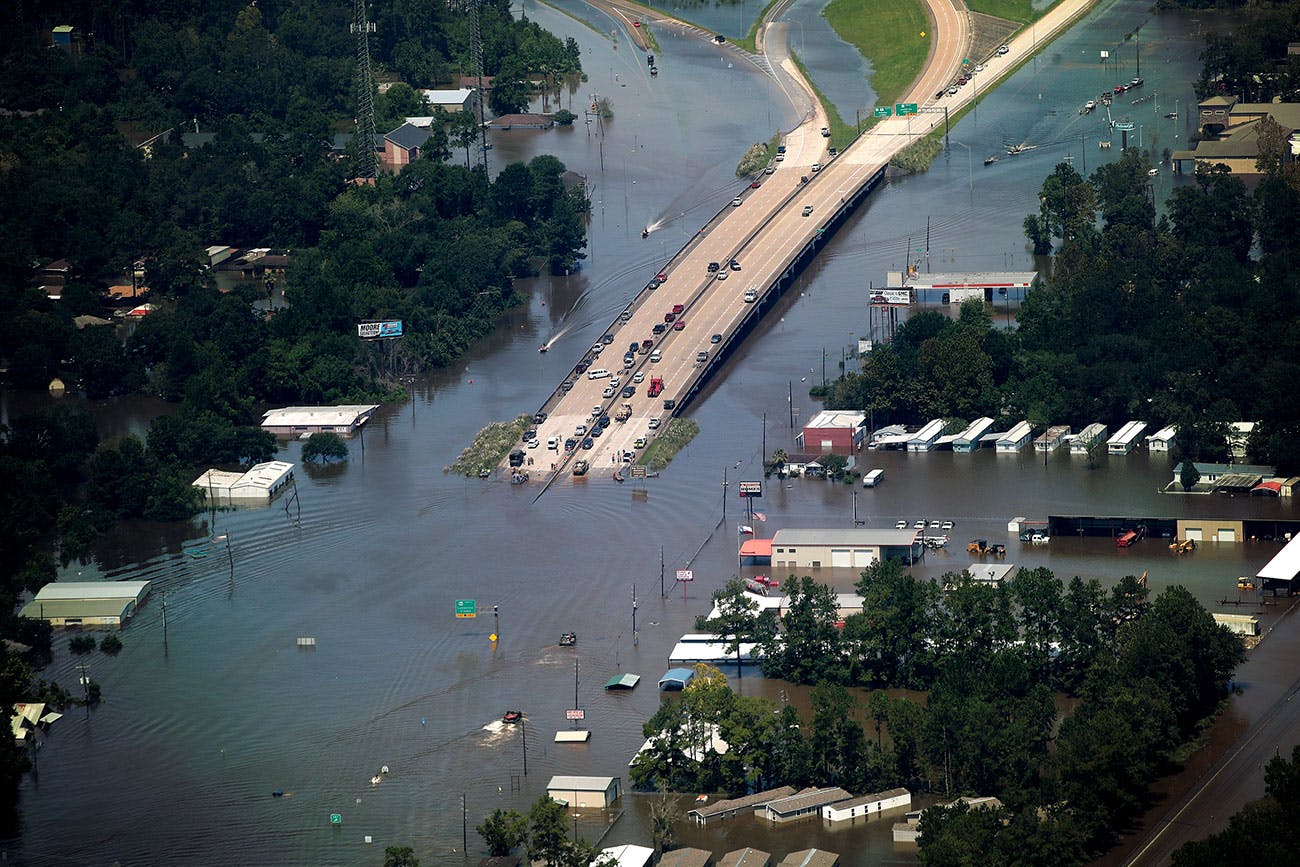
This article originally appeared in the October 2017 issue of Texas Monthly with the headline “It’ll Happen Again.”
Samuel Brody directs the Center for Texas Beaches and Shores at Texas A&M–Galveston, where he studies coastal environmental planning and natural hazards mitigation. Much of his work has focused on how unfettered development in the Houston area has created the perfect conditions for the kind of flooding that Hurricane Harvey delivered. His message hasn’t always been welcome, but now his audience is bigger than ever. We caught up with Brody a day after blue skies returned to the city.
Tom Foster: How did you hold up in the storm?
Samuel Brody: I’m pretty tired. We were trapped in our house in Houston for three days from high water, but fortunately didn’t get anything in the home, and we have power. I’m grateful that we were lucky compared to so many others.
TF: As you sat in your home, you must have been thinking a lot about how it compared to your worst fears.
SB: Yes, I think Harvey matches what I’ve feared. The last catastrophic rainfall event in Houston was in 2001, Tropical Storm Allison. Harvey is very reminiscent of that, a storm that stalls over Houston and continuously dumps rain. What’s different is not so much the amount of rain, because Allison had 35 or 36 inches. It’s the geographic scope. You’re talking about going from Galveston, on the coast, all the way north through the Woodlands, west through Katy, and east into Chambers County—an area that measures 75 by 70 miles. That’s a more-than-5,000-square-mile area of impact. And that’s just the Houston-area part of the storm.
TF: You were pretty sure a flood of this magnitude was going to happen sooner or later.
SB: We knew with certainty this would happen. We know Houston is threatened by both rainfall episodes and rising seawater episodes, such as storm surges. The flooding from Hurricane Ike, in 2008, was surge based. Ever since then, everyone has been chasing their tails worrying about storm surge, and I kept saying, “What if the next flood is 40 inches of rain, or Category 5 winds?” We can question what we could have done differently after Allison, but it’s more useful to just acknowledge that any planning from here on in has to consider multiple hazards.
TF: Because storm surges and rainfall produce different kinds of flooding?
SB: That’s right. Surge-based impacts tend to be concentrated more in floodplain areas, so they’re less widespread. Low-lying coastal areas get hit, but the water also gets forced up into the bayous and can flood there too. With this kind of heavy rainfall, though, you get flooding in those areas as well as urban areas away from the floodplain.
TF: This gets to the heart of your work about the impact of overdevelopment, right? The idea that an excess of paved areas and fewer natural wetlands prevent the ground from being able to absorb floodwaters.
SB: Exactly. I do a lot of mapping work to study areas of contiguous development, and Houston is one of the largest swaths of impervious land I can find, other than L.A.
TF: Can you point to any other city that has seen the kind of growth Houston has seen, coupled with a laissez-faire attitude toward zoning and development?
SB: Certainly not a city of this size. One of the things the team at the Center for Texas Beaches and Shores has spent a lot of time working on is building artificial-intelligence models that can predict where development is going to happen. You can see clearly how growth patterns today are going to put more people in danger. We are setting ourselves up for an even greater future disaster.
TF: So what do we do about it? It’s one thing to point to overdevelopment as a culprit, but that ship has sailed. The land’s developed.
SB: That might be the most important question. Houston is growing so fast. The metro area has added well over 100,000 people per year the past couple years. And we are at real peril if we don’t answer that question. Part of it will require retrofitting things that have already been built, and part of it will require recovering some of the land. And we have to think very carefully about where we’re going in the future, and how to go there in a more flood-resilient way.

TF: Where do you start?
SB: If I were the governor of Texas, I would choose a university that studies these issues and say, “I want a report of ten short-term things we can do in Houston starting now.” Not, “Let’s take three years to do a study,” but actionable things that don’t curtail growth but enable smarter growth, by putting in place systems that cope with and adapt to floods, both from rainfall and surge.
TF: Okay, let’s say I’m the governor. I’ve just appointed you to make the list. Go.
SB: First, put in place ways to think regionally and collaboratively across multiple counties and jurisdictions. These are regional landscapes and watersheds, and yet we don’t look at the consequences of development that way.
TF: That’s one of those things that sounds sensible but gets tangled with conflicting interests pretty quickly. What about more-tangible steps?
SB: There are three major bins of action: resistance, avoidance, and education. Resistance is about holding back the water, or focusing it into some engineered system. In addition to the bayous, Harris County has thousands of miles of channels that move the water out. This is the mission of the Harris County Flood Control District, and they do great work, but we need upgrades. We need to upgrade storm-drain systems, reinforce the reservoirs, build larger regional detention systems, which are similar to reservoirs, but there would be more of them. This is all important, but one thing we know from history is that just replumbing a system is not enough to deal with floods. It’s one part of the equation.
TF: So what else?
SB: Avoidance is another strategy. So, elevating structures, for instance, is what we call vertical avoidance. We need better and more consistent standards of elevation for new homes and need to think about retrofits for older homes. There’s a lot of technology out there that allows us to raise these structures out of harm’s way.
My focus is on horizontal avoidance, which means peeling away from these flood-prone, sensitive areas, like the bayous, and repairing those areas and creating buffers. This has two benefits: it gets people out of a dangerous situation, and it lets the land get back to doing its job of absorbing the water.
TF: Let’s dig in on that one, because it sounds like you’re talking about really reshaping the city. Is that realistic?
SB: Again, it’s partly about looking at existing structures and partly about where new development should occur—not just building where the next big roadway is going or where the land is cheap. This is simple wisdom like what your grandpa probably used to tell you.
TF: Can you give me an example?
SB: Let’s take Katy. There is overwhelming evidence, thousands of articles looking at the issue, that freshwater wetlands reduce flooding and flood damage. And yet parts of Katy Prairie have been converted from naturally occurring wetlands into parking lots, rooftops, and roadways. It was smart to put Addicks and Barker reservoirs out there to collect water. But a critical mistake was allowing subdivision development between the reservoirs and the runoff, directly in harm’s way.
It gets more complicated than that, though. We’ve found that freshwater wetlands, during heavy rainfall, not only reduce damage to immediately adjacent homes but do so for much larger areas. They are like organs in a larger regional body: critical areas that help the entire system function. Recognizing that should be a cornerstone of flood management and mitigation. Otherwise we’re just treating the symptoms of flooding, not the causes.
I’ll give you another example. In Meyerland, they are wisely expanding the detention pond and upgrading the storm-water system, because it’s flood prone. But really the problem is miles upstream, toward Katy, where development is putting more volume and velocity into Brays Bayou. People say, “Well, Meyerland shouldn’t have been built in the floodplain.” But it wasn’t actually in the floodplain when it was first built up, in the fifties. The floodplain expanded because of the upstream development. Think about that: not only are we moving into the floodplain but the floodplain is moving toward us.
I get calls all the time from people who say, “I have lived in this house for thirty years and it’s never flooded, and now it is.” I ask if there’s been any new development nearby, and it’s always, “Oh, yeah, the new shopping plaza” or whatever. The fact is, Houston is so low-lying, you sneeze and you change the floodplain. A new road here has a lot more impact than it would in Colorado or Pennsylvania.
TF: So this brings me back to the question of how much of the solution you’re proposing requires tearing things down, because how viable is that, really?
SB: I think buyouts and relocation are definitely part of the solution. Believe it or not, Houston already has more buyouts than anywhere in the nation. It’s a program that’s 75 percent federally funded and 25 percent local. It focuses on homes in the floodplain that have been repetitively and substantially damaged. I watch that and say, “Why do we need to wait?” Why not identify the homes before the flood and save all the money and pain of them having to be repaired three times before they’re bought out? If we provide the right incentives and do it proactively, then over time we can start to avoid these areas where it makes no sense to have a structure and convert them back to green space.
TF: If the answer is just to free up more of those spaces throughout the city and keep growing elsewhere, won’t that just amplify the city’s sprawl even more and create even more miles of roads?
SB: We have to focus on infill development, redirecting growth into more-urbanized areas, like the Heights and Montrose. What happens too often now is that developers build farther and farther out because that’s where the land is cheaper. So can we incentivize development that’s closer in? That’s what Atlanta has done.
TF: Much of what we’ve talked about so far sounds like the back-to-nature approach. Are there also technological solutions to some of these problems? Like more-permeable forms of pavement?
SB: That’s another important piece of this. There are portable levee systems that neighborhoods can put up and down as needed. There are permeable surfaces that soak in water better than any clay-based soil. I get calls from these companies all the time. The challenge is that these things tend to cost more in the short term, but the costs can come down as you use them more. The technology to raise buildings is gaining traction and becoming less expensive, for example.
TF: Are you arguing that the city should just use more of these materials going forward, or that they should tear up concrete and replace it?
SB: Again, it’s both. You might tear up some concrete and put in a new material. And put a cistern under it that feeds into a drainage system. That’s common in the Netherlands and some parts of the U.S. These are not radically new ideas. Instead of putting in a new sidewalk, what about just using crushed granite? It can be that simple—and that one would save money on the front end, by the way.
Maybe the state should aim to become the leader of technological development of these things. Start a center at one of the universities where you develop and test and apply these materials. Because it’s not just Houston where this is relevant; it’s Chicago, Miami, New York. Urban flooding is the hazard of the future.

TF: What can regular people do? Are they simply at the mercy of the government and developers, or can they help themselves too?
SB: This has become one of my biggest areas of focus, and it starts with education. Homeowners are just not aware of the risks and what they can do. Some of it is very simple: imagine what we could save in flood impacts if homeowners’ associations just had proactive programs to sweep out street drains that are clogged with debris and trash. I literally keep a broom in the back of my car for this purpose, as I drive around the city. Seriously.
A step back from that is providing information to people about the actual risks they face. My wife was looking at houses on Zillow recently, and there were all these charming ranch homes she’d show me. It would say they’re near nature, and they just redid the floors. And it says, “Never flooded, per seller.” Sounds great! But what’s happening is that the house is a flip. The current owner, who’s had it for a few months and did the renovation, never had it flood in that short time. In fact, it’s flooded three times in its history. I have the real data—I know.
Along with a colleague in Washington State, I’ve created a web tool that allows people to enter an address and get a risk score [www.texascoastalatlas.com/buyers
bewhere]. It’s all based on public records, but that information is hard for people to find for themselves, so we’re making it easier. Why can we see crime statistics on Zillow but not flood statistics? It makes no sense.
TF: What’s the single most important thing that can be done today to protect against the next big flood?
SB: The magic happens when you put together all the things we’ve talked about. It’s not one thing, it’s the effect of all those things working together, from the individual level all the way up to the wider region. That’s hard to pull off, but we could have another multibillion-dollar flood next year. Or next week. I see Harvey as an enormous opportunity to learn and take action. We can start right away with technology and education. Some of the benefits might play out longer term, but we can start doing it now.








